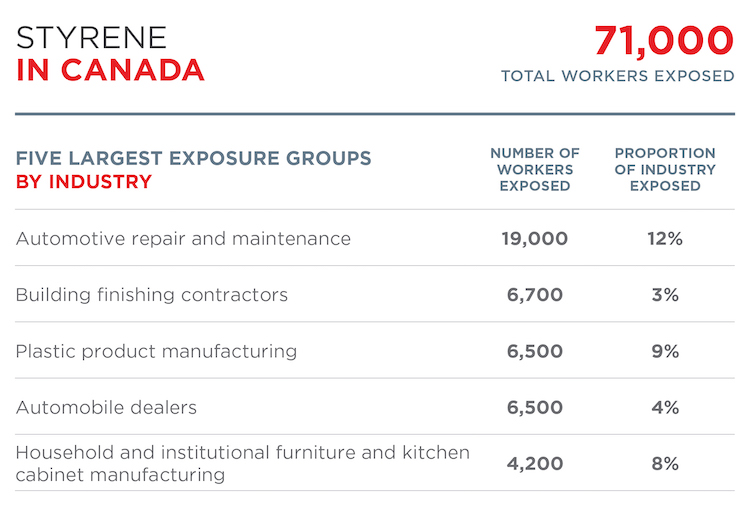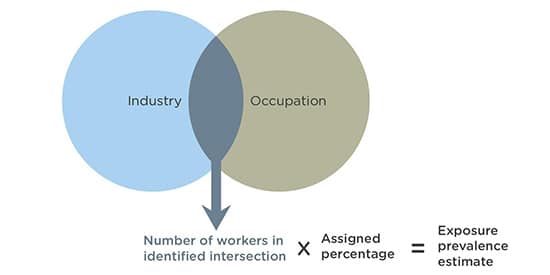Styrene and Styrene-7,8-Oxide Occupational Exposures
Styrene and Styrene-7,8-Oxide Occupational Exposures
Overview
Inhalation is the most important route of occupational exposure to styrene.[1]
CAREX Canada estimates that approximately 71,000 Canadians are likely exposed to styrene in their workplaces. The largest industrial groups exposed to styrene are automotive repair and maintenance, building finishing contractors, and plastic products manufacturing.
READ MORE...
The largest occupational groups exposed include automotive service technicians, motor vehicle body repairers, plastics processing machine operators, and furniture finishers and refinishers.
For workers involved in manufacturing polystyrene, styrene-butadiene (SB) rubber, acrylonitrile butadiene styrene (ABS) resins, and glass-reinforced plastic, exposure levels can be higher (generally <100 ppm, but higher levels have been reported).[1] Reinforced plastics are used in to make boats, automobile parts, shower stalls, tanks, and tubs.[1] In other styrene exposure scenarios, exposure levels are rarely reported above 20 ppm.[1]
Occupational exposure to styrene-7,8-oxide is primarily due to indirect exposure to styrene. This is because styrene is primarily metabolized via the styrene-7,8-oxide pathway in humans.[2] Styrene-7,8-oxide is also formed when styrene reacts with oxygen in air, or with other oxidizing agents in industrial processes.[3,4] Direct occupational exposure to styrene-7,8-oxide may also occur in workers involved in rubber product and paint manufacturing.[4]
Prevalence Estimate
Results show that approximately 71,000 Canadians are potentially exposed to styrene at work; 87% of these workers are male. The industry with the greatest numbers of exposed workers is automotive repair and maintenance, followed by building finishing contractors, plastic products manufacturing, and automobile dealers (where workers are exposed through repair activities via adhesives, paints and auto-body fillers containing styrene).
When exposure is examined by occupation, the largest exposed group is automotive service technicians (21,000 workers exposed), motor vehicle body repairers (5,200 workers exposed), plastics processing machine operators (5,100 workers exposed), and furniture finishers and refinishers (4,800 workers exposed).
The number of workers exposed to styrene decreased by approximately 18,000 workers from 2006 to 2016 (a 20% decrease). This was driven by a decrease in the total number of workers in the plastic product manufacturing and transportation equipment manufacturing industries.
Workers exposed to styrene by industry in 2016

Workers exposed to styrene by region in 2016
Click the second tab to view total number of workers exposed.
* = < 50 workers
Level of Exposure
In total, approximately 71,000 Canadians are exposed to styrene in their workplaces. The majority of workers exposed to styrene are in the moderate and high exposure categories.
Workers exposed to styrene by exposure level in 2016
Level of exposure by industry
Identifying industries with either 1) workers exposed to high levels of styrene or 2) a larger number of workers exposed to styrene is important in guiding cancer and other disease prevention efforts to prioritize exposed groups and target resources most effectively.
The table below shows the number of workers exposed by industry group and level of exposure to styrene. These results highlight industries with the most number of workers, as well as industries with the highest levels of exposure. For example, in the motor vehicle and parts dealers industry, all of the workers fall into the low and moderate exposure categories. However, in the two largest industries (repair and maintenance and plastics and rubber manufacturing), the majority of workers are in the high exposure category. Depending on the goals of a prevention campaign, exposure reduction in the large industrial group might be a useful strategy, or reducing exposure to those at highest risk of exposure could be seen as a priority.
Workers exposed to styrene by exposure level and industry in 2016
*Numbers may not add up due to rounding
Methods and Data
Our Occupational Approach page outlines the general approach used to calculate prevalence and exposure level estimates for workplace exposures.
Data Sources
Data used in developing the occupational estimates for styrene* were collected from several sources:
- The Canadian Workplace Exposure Database (CWED) contains approximately 7,700 measurements for styrene exposure. These measurements were collected during the years 1981 to 2004 in Ontario and British Columbia workplaces.
- Canadian and US scientific peer reviewed publications that addressed styrene exposure in Canada and the United States.
- Grey literature including technical reports from governments and international bodies.
*Occupational estimates for styrene and styrene-7,8-oxide were assessed by reviewing styrene exposure data in the CWED and other sources. Because styrene-7,8-oxide is a metabolite of styrene for humans and occupational exposure to styrene-7,8-oxide is primarily due to styrene exposure, most styrene-7,8-oxide exposures would be captured by our assessment. However, the estimates are likely to be conservative for styrene-7,8-oxide exposure, as infrequent direct exposures to styrene-7,8-oxide in some industries were not included. For more information regarding styrene-7,8-oxide and exposure to the substance, visit our profile.
Prevalence Estimate Method
CAREX defines exposure to styrene as inhalation or dermal exposure at work above levels that are generally encountered in the environment.
To determine the number of workers potentially exposed to styrene at work, CAREX occupational exposure experts used methods previously established in other peer-reviewed CAREX projects in Europe. A series of steps were taken to assign exposure proportions to occupations and industries at risk of exposure to styrene.

- Occupations and industries at risk of possible exposure to styrene were identified using any combination of data sources described above.
- The total number of workers in each identified occupation and industry intersection was obtained from Statistics Canada 2016 census data.
- A percentage of workers exposed was assigned to that occupation and industry intersection. Percentages were determined by consultation with existing evidence in the data sources, previously established methods from the Europe CAREX estimates and the expert judgement of CAREX occupational hygienists.
- The number of workers in the identified group is multiplied by the assigned percentage to calculate the prevalence estimate of workers exposed to styrene.
Exposure Level Method
CAREX uses available workplace exposure measurements in the CWED to create exposure level categories by industry and occupation. For styrene, these categories are:
Category 1: Low Exposure
A group of workers (people in the same job category and industry) is put in this exposure category for one of two reasons:
- The are no valid measurements, but a hygienist identified this group as typically exposed during literature and other reviews;
- There are valid exposure measurements in the CWED and a hygienist review determined that exposure is plausible; AND EITHER:
- There are less than 10 samples available in the CWED, OR
- There are ≥10 measurements available but they do not meet the criteria for Moderate Exposure.
Category 2: Moderate Exposure
A group of workers is put in this exposure category if:
- There are at least 25 individual samples in the CWED, AND
- 20% or more samples have a value higher than 10 ppm (which is ½ of the current occupational exposure limit for styrene),
OR
- There are at least 10, but less than 25, individual samples in the CWED, AND
- 20% or more samples have a value higher than 20 ppm (which is the current occupational exposure limit for styrene).
Category 3: High Exposure
A group of workers is put in this exposure category if:
- There are at least 25 individual samples in the CWED, AND
- 20% or more samples have a value higher than 20 ppm (which is the current occupational exposure limit for styrene).
Sources
Subscribe to our newsletters
The CAREX Canada team offers two regular newsletters: the biannual e-Bulletin summarizing information on upcoming webinars, new publications, and updates to estimates and tools; and the monthly Carcinogens in the News, a digest of media articles, government reports, and academic literature related to the carcinogens we’ve classified as important for surveillance in Canada. Sign up for one or both of these newsletters below.
CAREX Canada
School of Population and Public Health
University of British Columbia
Vancouver Campus
370A - 2206 East Mall
Vancouver, BC V6T 1Z3
CANADA
As a national organization, our work extends across borders into many Indigenous lands throughout Canada. We gratefully acknowledge that our host institution, the University of British Columbia Point Grey campus, is located on the traditional, ancestral, and unceded territories of the xʷməθkʷəy̓əm (Musqueam) people.



